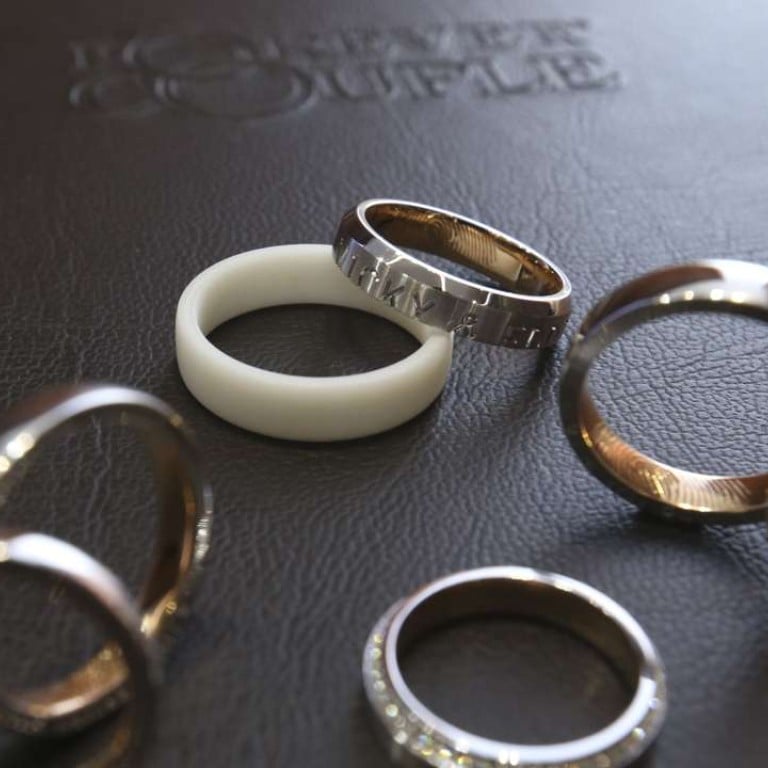
3D printing for wedding rings and other savvy Hong Kong 3D innovations
From jewellery to decorations, and from fashion accessories to orthopaedics, entrepreneurial Hong Kong companies are using 3D technology to save time and money, and heal people
Churning out rows of rings made of epoxy resin at high speed, the whirring new 3D printing machine at Forever Couple, a jewellery shop in Wan Chai, intrigues customers who are looking to buy bespoke wedding rings.
With this technology, there is no longer any need to try on rings of different sizes before finding one that best fits; the “printed” edition is made according to minute measurements, and can be tested for up to six months, before it is cast in metal. A commercial gimmick perhaps, but it is becoming popular among consumers.

Eddie Lai Yiu-kwong says the machine is a joint invention between his company Forever Couple and the Hong Kong Productivity Council.
“People have different finger shapes,” he says, adding that measurements made by salespeople may not always be accurate. “If a customer finds that his wedding ring is not comfortable, they have to make another one, which wastes time and money. So the exact measurement of the finger is very important.”
Once a technology confined to laboratories and factory floors – it’s been around since the 1980s – 3D printing is now pervading many parts of daily life, from fashion to medicine to engineering.
In Hong Kong, companies making use of the technology to offer personalised services have been popping up all over the city. Apostrophe’s was set up two years ago to produce 3D figurines for individual clients, pop concerts and entertainment events.
Its creative director Yuk Wong says the use of 3D printing technology has greatly reduced the time cost for the printing industry.
“Last year, we helped the fashion chain Gap design a series of flip-flops. We 3D printed a series of designs in sandstone for Gap to pick. Once chosen, the designs were instantly sent to the mainland for manufacturing. The whole process was sped up due to the use of 3D colour printing,” she says.

Apostrophe’s was also behind the souvenirs for Denise Ho Wan-sze’s Hong Kong Coliseum concert in October – a black candle in the likeness of the pop singer.
“The 3D printed mould of her visage was made in one day,” says Wong. “A high degree of reality can also be attained by the use of 3D printing.”

“Last year, we collaborated with Madame Tussauds on The Peak and set up a booth in the museum,” recalls Wong. “After looking at all the waxworks, visitors might want one of themselves. After scanning their face we made figurines in sandstone with a 3D printer.”
The technology is not just for entertainment and has real, practical value, especially in the field of medicine.
The department of orthopaedics and traumatology at the University of Hong Kong, a new 3D printing machine is producing simulated bone implants to be used on mice in clinical research.
The equipment was recently bought from Switzerland for HK$2 million. Kelvin Yeung Wai-kwok, associate professor with the department, says they aim to set up the first human tissue 3D printing centre within five years.

“So far in Hong Kong, 3D printing has been used in making medical tools only,” he explains. “There’re never any cases that implants made from 3D printing are used on the human body. In Asia, 3D printing in the medical field is mostly at the stage of clinical trial.”
The 3D printing machine at HKU prints implants for mice using different kinds of materials like bio-degradable polymers and hydroxylapatite.
Researchers are doing trials on different kinds of ink to see which material better matches cell growth.
“Live cells are put into the ink. The ink is for the construction of a matrix-like scaffold for the cells to live in. If the cells find the scaffold a nice and cosy home, they will duplicate endlessly and grow and later transform into fat, muscle, bone, ligament or nerve tissue.
“The 3D printing machines can manufacture the matrix-like scaffold. We will first print bones, then ligament and nerves and ultimately, spinal cords which can help [paralysed] patients walk again.”

“You can make tiny holes in a 3D printed bone implant that traditional mould-making tools can never do. The presence of the holes increases surface area. The more surface area the cells come into contact with, the better the bone growth.”
Yeung adds that the introduction of 3D printing can help rectify the shortcomings of traditional orthopaedic treatment.
“For example, a patient shatters a leg bone in an accident. He may have a limp after surgery because his injured leg shorter than the healthy one as the bone doesn’t grow that well during the healing process,” says Yeung.
“To rectify this, we normally use bone from a cadaver or the patient’s own bone from another part of his body [to elongate the shorter leg]. But both these methods are flawed as donated bone from cadaver can lead to disease transmission and the supply of one’s own bones is limited.
“3D printed bone implants can help solve this problem.”

